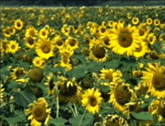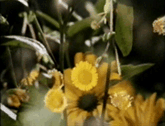 Les Tournesols, 1982. In some ways, Rose Lowder’s Les Tournesols, a kinetic, color-saturated, Vincent Van Gogh-esque structural film could just as easily have fit Jean-Luc Godard’s description of “blind, trembling pans” as interior representations of the artist’s psychological state (as Godard once described Alain Resnais’ Van Gogh). Composed of frame by frame stationary shots of a lush field of sunflowers in full bloom near Bédarrides, Vaucluse where the focus of each successive image varies according to prescribed subject patterns – the fluttering of petals, the (sideways) bending of the wind, the cross-pollination of bees, the casting shadows by passing clouds – the apparent movement in the film results from the individual frame changes in the depth of field. Rather than simply capturing the diurnal, two-dimensional, to and fro motion of sunflowers swaying in the breeze, the focal modulation results in a momentary (single frame) displacement perpendicular to the plane of the film frame, causing the resulting image to appear to pulse. Expounding on the ideas presented in her first film, Roulement, Rouerie, Aubage, Lowder’s trompe l’oeil “still life” composition is similarly rooted in the mechanism of the mind-eye’s registration of images, where the placement of the frames of an image within the continuity of a film strip itself alters its apparent behavior. Creating an increasingly animated portrait of the verdant sunflower field as the natural movement of the sunflowers seemingly triggers a corresponding, proportional change in the camera’s alternating focal length, the resulting image becomes a dynamic reflection of the subject itself in its rustic beauty and irresistible vibrancy.
Les Tournesols, 1982. In some ways, Rose Lowder’s Les Tournesols, a kinetic, color-saturated, Vincent Van Gogh-esque structural film could just as easily have fit Jean-Luc Godard’s description of “blind, trembling pans” as interior representations of the artist’s psychological state (as Godard once described Alain Resnais’ Van Gogh). Composed of frame by frame stationary shots of a lush field of sunflowers in full bloom near Bédarrides, Vaucluse where the focus of each successive image varies according to prescribed subject patterns – the fluttering of petals, the (sideways) bending of the wind, the cross-pollination of bees, the casting shadows by passing clouds – the apparent movement in the film results from the individual frame changes in the depth of field. Rather than simply capturing the diurnal, two-dimensional, to and fro motion of sunflowers swaying in the breeze, the focal modulation results in a momentary (single frame) displacement perpendicular to the plane of the film frame, causing the resulting image to appear to pulse. Expounding on the ideas presented in her first film, Roulement, Rouerie, Aubage, Lowder’s trompe l’oeil “still life” composition is similarly rooted in the mechanism of the mind-eye’s registration of images, where the placement of the frames of an image within the continuity of a film strip itself alters its apparent behavior. Creating an increasingly animated portrait of the verdant sunflower field as the natural movement of the sunflowers seemingly triggers a corresponding, proportional change in the camera’s alternating focal length, the resulting image becomes a dynamic reflection of the subject itself in its rustic beauty and irresistible vibrancy.
 Quiproquo, 1992. Set against the sound of an aggressive drumbeat, Quiproquo opens to the successive images of an errant, bobbing, plastic bottle floating towards the foreground, a man seemingly walking on water towards the left of the frame, and a duck floating backwards to the right of the frame against the powerful current of a body of water. The opening montage serves as a distilled metaphor for the divergence of nature, humanity, and technology in contemporary society. Incorporating structural techniques from her earlier films – most notably, in the repeated, subtly modulated landscape shot of a nuclear power plant that is bisected by a train (that recalls the shifting aesthetic imagery of Roulement, Rouerie, Aubage) and a cherry blossom-laden tree that, in its shimmering whiteness, appears incandescent (a visual created by the asequential, odd-even frames that Lowder studies in Impromptu) – Quiproquo is an abstract and freeform, yet cohesive rumination on the fragile intersection of industrialization and environment, where the coexistence of development and natural preservation create an essentially bifurcated landscape (note Lowder’s bisection of the horizon that anticipates James Benning’s Thirteen Lakes). Using stationary images that are subsequently animated through alternating shot frames, the manic collage of disparate ecological images and ever-shifting soundscapes becomes an integral representation of our own irreconcilable relationship with the environment.
Quiproquo, 1992. Set against the sound of an aggressive drumbeat, Quiproquo opens to the successive images of an errant, bobbing, plastic bottle floating towards the foreground, a man seemingly walking on water towards the left of the frame, and a duck floating backwards to the right of the frame against the powerful current of a body of water. The opening montage serves as a distilled metaphor for the divergence of nature, humanity, and technology in contemporary society. Incorporating structural techniques from her earlier films – most notably, in the repeated, subtly modulated landscape shot of a nuclear power plant that is bisected by a train (that recalls the shifting aesthetic imagery of Roulement, Rouerie, Aubage) and a cherry blossom-laden tree that, in its shimmering whiteness, appears incandescent (a visual created by the asequential, odd-even frames that Lowder studies in Impromptu) – Quiproquo is an abstract and freeform, yet cohesive rumination on the fragile intersection of industrialization and environment, where the coexistence of development and natural preservation create an essentially bifurcated landscape (note Lowder’s bisection of the horizon that anticipates James Benning’s Thirteen Lakes). Using stationary images that are subsequently animated through alternating shot frames, the manic collage of disparate ecological images and ever-shifting soundscapes becomes an integral representation of our own irreconcilable relationship with the environment.
 Bouquets 1-10, 1994-1995. Bouquets 1-10 is Lowder’s first collection in an ongoing series of one minute segments, each composed of footage shot around a general geographic location that has been alternately woven, frame by frame, into a single film reel and connected through the interstitial still life image of a flower that cues the beginning of each integrated film Bouquet. In Bouquet 1, a day of leisure at Mount Ventoux, Vaucluse juxtaposes the vibrant image of indigenous flowers with the equally colorful bins of candy. In Bouquet 2, a seemingly uninterrupted study of flowers near the village of Brantes is eventually disrupted by the passing of cyclists in the last few moments of the film. Perhaps the most memorable is Bouquet 3, set in the village of Roquevaire, Var on the banks of the Huveaune River featuring a nondescript, old-fashioned pedestrian bridge that, interwoven with images of colorful wildflowers, optically transforms into impressionistic, Claude Monet-like compositions. In Bouquet 4, wildflowers and weather worn local handicrafts represent the slowly disappearing, rustic panorama of Beauduc, Camargue, Bouches-du-Rhône. Bouquet 5 illustrates the inevitable intersection between environment and technology as commuters figuratively share the same space as a field of poppies near the Marseille-Paris railway line. Work and leisure intersect in Bouquet 6 at a fishing harbor in Vesse, Bouches-du-Rhône, as boats are summarily abandoned in favor of a recreational swim in the idyllic blue waters. The image of water carries though to the therapeutic springs of Fosse Dionne in the medieval town of Tonnerre in Bouquet 7, where the wildflowers emerge from the interstices and abandoned ruins. In Bouquet 8, the absence of flowers on the beach at Beauduc, Bouches-du-Rhône is replaced by brightly colored sailboards that dart in and out of the horizon. The uneasy intersection between humanity and environment resurfaces in Bouquet 9 on the open fields near Signes, Var as assorted, discarded junk litter a field of buttercups. In Bouquet 10, the swarm of pollinating insects near the conclusion of the episode serves as a tongue-in-cheek metaphor for the influx of vacationing tourists on Lake Serre-Ponçon, Hautes-Alpes near a pastoral town on the mountain ranges of St. Apollinaire.
Bouquets 1-10, 1994-1995. Bouquets 1-10 is Lowder’s first collection in an ongoing series of one minute segments, each composed of footage shot around a general geographic location that has been alternately woven, frame by frame, into a single film reel and connected through the interstitial still life image of a flower that cues the beginning of each integrated film Bouquet. In Bouquet 1, a day of leisure at Mount Ventoux, Vaucluse juxtaposes the vibrant image of indigenous flowers with the equally colorful bins of candy. In Bouquet 2, a seemingly uninterrupted study of flowers near the village of Brantes is eventually disrupted by the passing of cyclists in the last few moments of the film. Perhaps the most memorable is Bouquet 3, set in the village of Roquevaire, Var on the banks of the Huveaune River featuring a nondescript, old-fashioned pedestrian bridge that, interwoven with images of colorful wildflowers, optically transforms into impressionistic, Claude Monet-like compositions. In Bouquet 4, wildflowers and weather worn local handicrafts represent the slowly disappearing, rustic panorama of Beauduc, Camargue, Bouches-du-Rhône. Bouquet 5 illustrates the inevitable intersection between environment and technology as commuters figuratively share the same space as a field of poppies near the Marseille-Paris railway line. Work and leisure intersect in Bouquet 6 at a fishing harbor in Vesse, Bouches-du-Rhône, as boats are summarily abandoned in favor of a recreational swim in the idyllic blue waters. The image of water carries though to the therapeutic springs of Fosse Dionne in the medieval town of Tonnerre in Bouquet 7, where the wildflowers emerge from the interstices and abandoned ruins. In Bouquet 8, the absence of flowers on the beach at Beauduc, Bouches-du-Rhône is replaced by brightly colored sailboards that dart in and out of the horizon. The uneasy intersection between humanity and environment resurfaces in Bouquet 9 on the open fields near Signes, Var as assorted, discarded junk litter a field of buttercups. In Bouquet 10, the swarm of pollinating insects near the conclusion of the episode serves as a tongue-in-cheek metaphor for the influx of vacationing tourists on Lake Serre-Ponçon, Hautes-Alpes near a pastoral town on the mountain ranges of St. Apollinaire.
Acquarello, 2007 [reprinted].